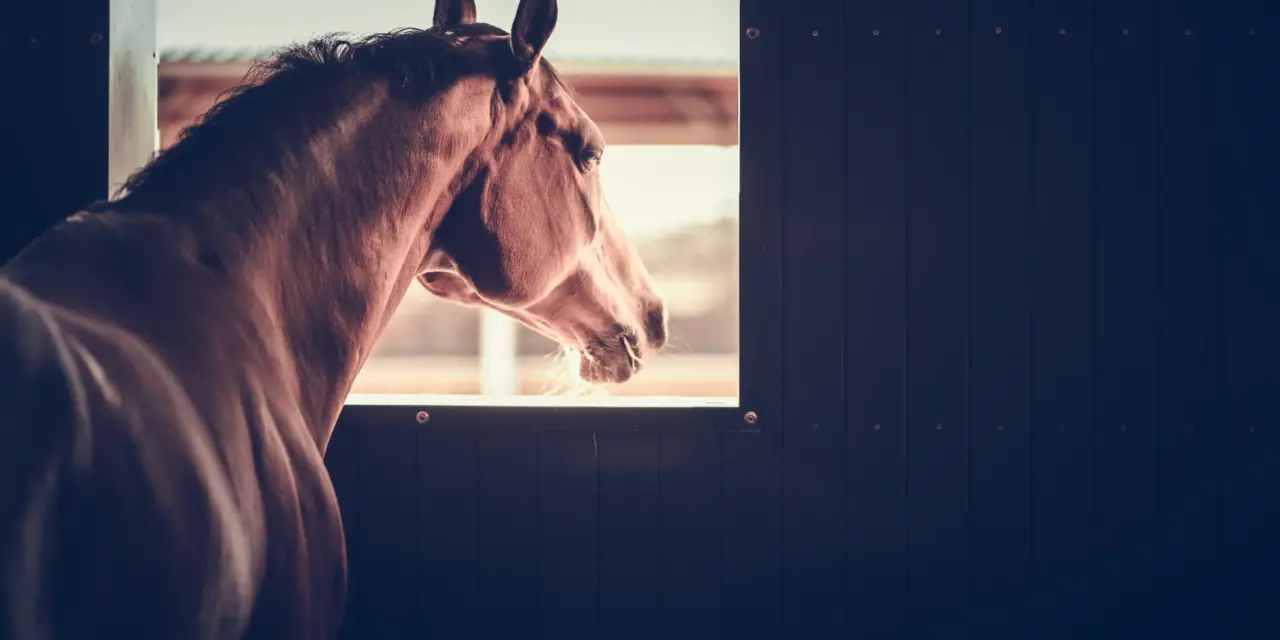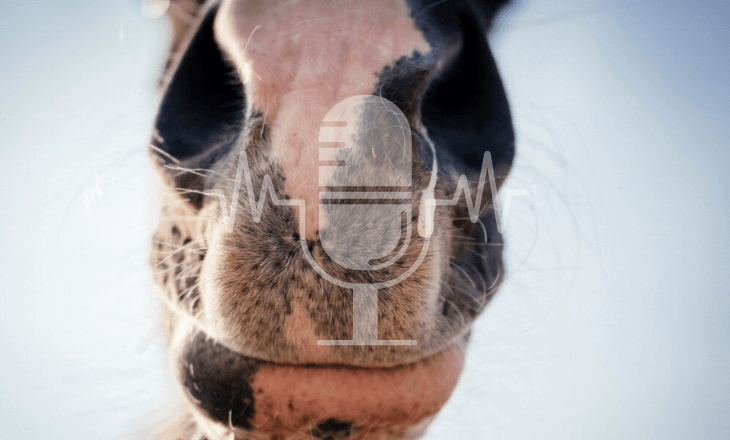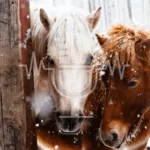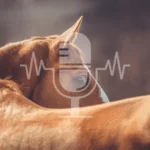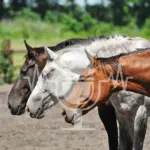How poor management leads to illness — and why many problems are home-grown
Key points at a glance:
- Around 70% of equine health problems are linked to unsuitable housing and management conditions
- Stereotypies such as weaving, crib-biting and box-walking, as well as so-called “narcolepsy”, are clear warning signs of psychological stress and unmet basic needs
- Insufficient movement causes colic, muscle atrophy and cardiovascular issues — often with life-threatening outcomes.
- Poor air quality in the stable and dusty bedding cause chronic respiratory disease, drastically reducing life expectancy
- Social isolation and unnatural feeding practices are leading causes of behavioural disorders and gastric ulcers
- In group (loose) housing, mismatched or oversized groups, poorly socialised horses, and cramped turnout or resting areas are among the main causes of health problems
- Early detection and consistent improvements to management can prevent or resolve most problems
Most horse owners think of infections, injuries or genetic predispositions such as PSSM when they hear “illness”. The possibility that management alone can cause illness is often ignored or minimised. Yet the link between housing/management conditions and health problems is clearly established scientifically.
Most horse owners think of infections, injuries or genetic predispositions such as PSSM when they hear “illness”. The possibility that management alone can cause illness is often ignored or minimised. Yet the link between housing/management conditions and health problems is clearly established scientifically.
The body initially responds to these unnatural conditions by trying to adapt: hormones are released, metabolic processes shift, behaviour changes. But when stress becomes chronic and basic needs remain unmet, the system tips over — adaptation turns into disease.
What makes this especially insidious is that many management-related problems develop gradually. It can take months or years for stressed behaviour to turn into overt disease. By then, the original link to how the horse is kept is often no longer evident — or simply isn’t made.
When management takes its toll
The economic costs of management-related disease are enormous. Horses kept in problematic systems can incur veterinary costs that are easily twice those of animals managed appropriately. Add in reduced usability, shortened lifespan, specialist feed or equipment (e.g. sweet-itch rugs or remedial/orthopaedic shoeing) and depreciation in value, and the scale becomes even clearer.
The emotional costs are higher still: the animals’ suffering, owners’ sense of helplessness, and often years of treatment attempts weigh on everyone involved. Many of these problems could be avoided entirely with better management.
Stereotypic behaviour: a cry for help
Stereotypies are repetitive, purposeless movements or behaviours that commonly occur in horses kept under poor conditions. They are more than just “bad habits” — they are clear warning signs of psychological stress and unmet basic needs.
Weaving
Weaving is a side-to-side shift of weight from one foreleg to the other, often accompanied by pendulum-like head movements. Affected horses usually stand at the stable door or along a fence and “sway” back and forth for hours. This behavioural disorder arises almost exclusively in horses with a severe lack of movement. Weaving is the body’s desperate attempt to satisfy the urgent need for motion. At the same time, it serves as a release valve for pent-up stress and frustration.
Weaving leads to uneven loading of the joints and can promote osteoarthritis. Many horses that weave also develop heart problems, as the constant tension overloads the cardiovascular system. Life expectancy can be markedly reduced.
Crib-biting (cribbing)
Crib-biting involves the horse fixing its upper incisors to a surface, tightening the neck and drawing in air with a grunt. It can become compulsive, lasting for hours. The main drivers are stress, boredom and frustration; prolonged periods without forage and high-energy concentrates exacerbate it.
The mechanical strain on the teeth during crib-biting causes abnormal wear and dental problems. Some horses wear their incisors down completely, making it difficult to eat. Gastric ulcers and colic are common associated conditions in horses that crib-bite.
Box-walking
Box-walking horses pace restlessly along the same paths through their box or paddock. This endless pacing is an attempt to satisfy their natural need to move from place to place.
Box-walkers are often highly intelligent, sensitive horses that suffer particularly from confinement. Constant pacing causes uneven loading and can lead to joint, tendon and ligament damage. At the same time, the behaviour itself amplifies their restlessness.
Why stereotypies seem ‘catching’
Stereotypies can catch on in a yard — not because they’re contagious, but because horses copy what they see. Horses learn by watching and often copy their neighbours’ behaviour. If one horse starts weaving, the horses in the adjoining boxes often begin as well. This shows how similarly horses respond under similar conditions — and how important social learning is. Crucially, stereotypies only arise as a behavioural outlet where basic needs aren’t met. If there’s no reason for stereotyped behaviour, the rest of the group won’t copy it — even if one horse continues to crib-bite or weave because it can’t fully break out of its behavioural loop.
Standing still makes horses ill
Lack of movement is one of the biggest drivers of disease in modern horse management. The consequences are varied and often life-threatening, but they develop insidiously over months or years.
The heart and circulation are hit first
Horses have an extremely capable cardiovascular system, but it needs regular training. A lack of movement leads to wasting of the heart muscle, reduced pumping capacity and poorer blood flow to all organs.
Affected horses tire quickly, even with light work. Their recovery time after exertion lengthens markedly. In extreme cases, merely moving into trot can trigger circulatory problems.
The reduced cardiac output has consequences for the whole body: poorer wound healing, increased susceptibility to infection and lower stamina are the norm. Many horses kept in boxes only are physically “old” by the age of ten and often have to be retired from active use.
Digestion falls out of rhythm
The digestive system relies on constant, moderate movement. The natural trunk motion during locomotion gently massages the abdominal organs and helps move gut contents along. Without this “internal massage”, digestion slows — which, given the length of the equine gut, can quickly become a problem.
Colic is, on average, three times more common in low-movement horses than in those with adequate exercise. Impaction colic and gas colic are particularly linked to slowed gut motility.
The liver also suffers when movement is lacking: its detoxification function declines and fat deposition can occur. This, in turn, makes horses more susceptible to other diseases and reduces their ability to recover.
Muscle wastage and stiff joints
“Use it or lose it” applies especially to a horse’s muscles and joints. After just a few weeks without adequate movement, muscle wastage begins. Most affected are the postural and supporting muscles, which are essential for a healthy topline and self-carriage.
Weak muscles lead to poor posture and overloading of other structures. Back problems, tendon injuries and osteoarthritis are common consequences. Paradoxically, lack of movement causes more injuries, not fewer — something to bear in mind especially with sport horses kept in boxes, many of whom leave competition as early as eight to ten years old due to lameness that can no longer be treated.
Joints need movement to produce synovial fluid. Without this “lubrication” they stiffen and the cartilage is less well nourished. Osteoarthritis can develop even in young horses if they don’t get enough movement.
Respiratory disease on the rise
Respiratory problems are among the most common management-related issues and can drastically reduce quality of life. Most cases stem from poor stable air and dusty bedding.
When it ends in equine asthma
Chronic obstructive bronchitis (COB/COPD), often referred to colloquially as “hay dust allergy”, typically progresses over time to equine asthma — the end stage of chronic airway irritation. Affected horses have persistently narrowed bronchi and suffer from chronic coughing and shortness of breath.
This condition arises almost exclusively from poor management. A combination of mouldy, dusty hay, ammonia-laden stable air, poor ventilation (e.g. windows shut in winter to stop the drinkers freezing), together with inappropriate feeding, unsuitable medication, and/or chronic stress is usually what drives the respiratory problem.
Horses with chronic cough or equine asthma can only be worked lightly and require lifelong medical management. Their life expectancy is reduced by years, and their quality of life is severely limited unless the underlying causes are urgently addressed. All too often, a change in the management system — away from closed stabling towards more fresh air and freedom — is only considered once the airways have already been permanently damaged.
Mould-spore allergy
Many horses develop allergies to components of hay and straw, especially to mould spores. These allergies usually arise from a mix of dusty forage and poor stable air, compounded by lack of movement and a disrupted digestive system — because lung health and hindgut health are closely linked.
Affected horses often start to cough and lose performance as soon as dry—or merely moistened—hay is fed. However, moving to properly steamed hay usually leads to a clear improvement. If ignored, these allergies can soon progress to equine asthma; early diagnosis, strict dust reduction, and basic changes in management and feeding can often prevent this.
Ammonia build-up in stables arises when specialised microorganisms in the bedding break down urea from urine and proteins in manure. The resulting volatile ammonia accumulates mainly near the floor, irritates the respiratory mucosa and can lead to chronic inflammation.
A particular problem is that humans detect ammonia at much higher concentrations than horses. What still smells “normal” to us may already be harmful to a horse. A useful reality check is to sit on the floor of the stable before mucking out for half an hour — putting your airways where the horse’s are when it eating hay of the floor or sniffing through the bedding. It usually doesn’t take long before you feel your own airways and mucous membranes reacting — you want to get out of the stable straight away.
Chronic ammonia exposure doesn’t just weaken the respiratory lining; it also suppresses the immune system, leaving horses more prone to respiratory infections, which in turn can lead to chronic coughing. The eyes can be affected too, with chronic conjunctivitis and persistent tearing.
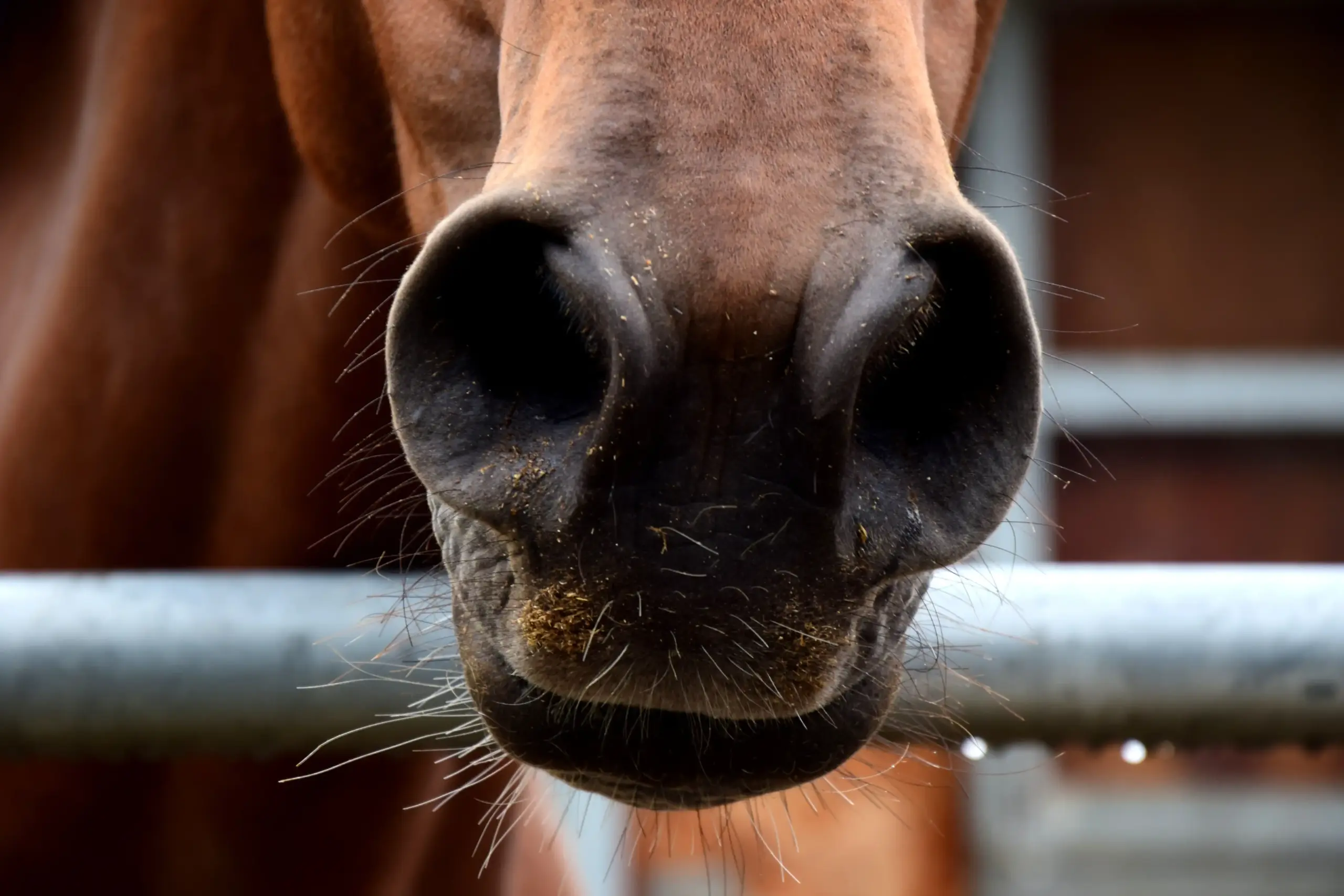
Social isolation is stressful for horses
Horses are herd animals, and social isolation fundamentally contradicts their nature. The consequences range from behavioural disorders to physical disease.
Gastric ulcers from stress
Chronic stress caused by social isolation is a major trigger of gastric ulcers in horses. The lack of social contact diminishes the stomach’s protective barriers against acid; that acid then attacks the unprotected lining, causing painful inflammation and ulceration.
Affected horses often show non-specific signs: loss of appetite, weight loss, changes in behaviour, or a tendency to colic. Without treatment, the ulcers can progress to life-threatening gastric perforation.
Immune weakness from chronic stress
Chronic stress elevates cortisol levels, which suppress immune defences. Ongoing stress from social isolation therefore markedly weakens the immune system. Affected horses fall ill more often, wounds heal poorly, and they’re more prone to parasites. Many horses that seem “prone to illness” are, in truth, simply stressed by poor management. Improving their social environment can work wonders.
Incorrect feeding is another major driver of management-related disease. Long breaks without forage, feeding via forage dispensers or automatic hay-racks, inappropriate feeds, or too few feeding places can all have serious consequences.
Choke or colic from bolting feed
Horses that eat hastily after long breaks between feeds can develop choke or, later on, colic. In choke, a poorly chewed bolus of feed gets stuck in the “throat” (i.e. the oesophagus) and cannot be moved on. These emergencies usually arise from inappropriate feeding routines, such as: Large feeds after long feed breaks encourage greedy bolting. Concentrates, apples, carrots or dry bread are especially problematic if given after an enforced break, as with meal feeding. Choke is life-threatening and requires immediate veterinary attention. Prevention: offer frequent, small feeds and ample forage.
The growing automation of horse stables has its downsides: forage dispensers and automatically closing hay-racks are often used to reduce overall intake by forcing horses to endure feeding breaks. However, studies show that such systems markedly increase stress levels, provoke more aggression, and lead to bolting when the horse is finally allowed back to the hay. The result is not only greater total intake over 24 hours than with continuous access, but also poorly chewed hay that is harder to digest and can trigger colic.
Once the digestive tract has been disrupted by persistently inappropriate feeding management, treatment is often lengthy and expensive. It’s therefore best to act early if the yard’s management isn’t horse-appropriate.
Spotting the early signs
Many management-related problems can be spotted and addressed early, before they become overt disease. What matters is paying attention to subtle changes in behaviour and appearance.
Horses often show stress and discomfort through changes in behaviour long before physical signs appear. Reduced appetite, listlessness or aggression can be early clues. If there are squabbles when the hay-racks are refilled, the group likely has too little hay — enforced breaks in forage are creating stress.
Shifts in social interaction matter too: if a usually sociable horse starts to withdraw, or a calm horse becomes restless (or a lively one suddenly seems unusually “quiet”), it’s time to look for the underlying cause.
Be especially alert to the onset of stereotypies. They don’t appear overnight; they develop gradually. Early intervention and changes to management can often prevent the behaviour from becoming established.
Interpreting physical signs correctly
Physical changes can also be early warning signs. Frequent yawning, altered eating patterns, girth sensitivity (girthiness), and more can indicate stomach problems. Lying down more than usual points to joint issues or the onset of laminitis. Round, scuffed wounds on the fronts of the fetlocks or carpi (knees) suggest so-called “narcolepsy” — in other words, sleep deprivation. Changes in posture, such as standing camped under (bringing the limbs under the body), often indicate pain or discomfort.
Documentation and monitoring
A management diary can help you spot links between housing conditions and health problems. Note changes in the weather, feed, or herd composition. Regular photos — or using the free Sanoanimal app — can help document gradual shifts in body condition or posture. What you see every day often slips by unnoticed; photos make changes visible.
Prevention is better than cure
The best treatment for management-related disease is to prevent it. Preventive measures are usually simpler and cheaper than later interventions.
Adequate movement, appropriate social contact and species-appropriate feeding are the cornerstones of good management. When these needs are met, most management-related problems don’t arise in the first place. Aim for at least 6–8 hours (preferably 12) of free movement daily. Social contact with other horses is essential — even if it’s only visual contact. Feeding should follow natural rhythms: continuous access to good-quality hay; turnout in summer where possible; and supplementary feed only in small amounts, tailored to the individual’s needs.
Good stable air, free from ammonia and dust, is essential for respiratory health. Adequate ventilation without draughts, low-dust bedding, and high-quality hay are basic requirements — non-negotiable. Stable design should minimise injury risk and provide comfort. Sharp edges, slippery floors, and spaces that are too tight are hazards that must be eliminated
Regular checks
Daily observation and routine health checks help you spot problems early. Record weight, condition and behaviour in a diary—especially if you suspect the management isn’t quite right. Schedule professional checks with an equine dental technician or vet, a farrier, and, where appropriate, a nutritionist or a manual therapist. Many issues are only picked up by trained eyes.
Healing through better management
Many management-related conditions can be cured — or at least improved — by consistently improving the way horses are kept.
Contrary to popular belief, stereotypic behaviours often lessen markedly once the triggers are removed. Adequate movement, meaningful occupation and social contact can reduce or even eliminate compulsive behaviour. Patience is crucial: stereotypies that have developed over years won’t vanish overnight. It often takes months for a horse to truly settle into a new management system and for clear improvements to show.
Chronic respiratory disease can, in most cases, improve markedly—and in some horses resolve completely—provided you intervene early. Loose housing, or at least a stable with an attached pen (paddock) where the horse can eat its forage in fresh air, can work wonders. Properly steamed hay and targeted airway therapy are usually the extra building blocks that drive recovery. Even many horses with equine asthma can improve significantly under optimal conditions and return to light work. What matters most is consistent avoidance of all irritants and a gentle, progressive training plan.
Gastric ulcers often heal surprisingly quickly once the sources of stress are removed. Social contact, continuous access to good-quality hay, and stress reduction through optimised management can lead to clear improvement within weeks. Any medical treatment should always go hand in hand with management changes. Without tackling the causes, the problems soon return.
Better management as treatment
Realising that management can make horses ill is painful, but important. More important still is recognising that better management can heal. Many problems that seem incurable resolve when a horse’s basic needs are respected.
The first step is an honest stocktake: are the horse’s basic needs being met? Are there warning signs that have been overlooked? What improvements are possible — and necessary?
The second step is having the courage to change. Sometimes that means letting go of familiar routines or making financial investments. But a horse’s health is worth the effort.
Species-appropriate management is the best medicine — and the best prevention. Give your horse a life that fits its nature and you’ll be rewarded with a healthy, balanced partner. The alternative is a life of vet visits, medication and suffering. The choice is ours — every single day.
- Podcast #8 – When the Cold Wave Hits Your Barn: How to Help Horses with Colds and Respiratory Infections - 9. October 2025
- Podcast #7 – Pasture Management for Laminitis-Prone Horses: What Every Horse Owner Needs to Know - 9. October 2025
- Podcast #6 – Clipping, Blanketing, or Fluffy Coat? How to Keep Your Horse Comfortable in Winter - 9. October 2025

